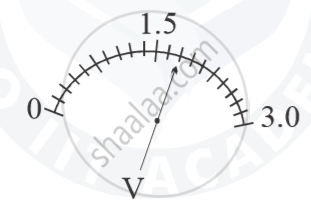Advertisements
Advertisements
प्रश्न
The graph between V and I for a conductor is a straight line passing through the origin.
What should remain constant in a statement of this law?
उत्तर
Ohm's law is true only if the temperature of the conductor is constant.
APPEARS IN
संबंधित प्रश्न
Keeping the p.d. constant, the resistance of a circuit is halved. The current will become:
(a) one-fourth
(b) four time
(c) half
(d) double
The graph between V and I for a conductor is a straight line passing through the origin.
Which law is illustrated by such a graph?
In the circuit shown below in Fig, calculate the value of x if the equivalent resistance between A and B is 4 Ω.

Consider the sacle of voltmeter shown in the diagram and answer the following questions :

(a) What is the least count of the voltmeter?
(b) What is the reading shown by the voltmeter ?
(c) If the voltmeter is connected across a resistor of 20 `Omega` how much current is flowing through the resistor?
Define ampere and volt with respect to Ohm’s law.
What are ohmic conductors? Give one exmaple. Draw a graph showing the current-voltage relationship for an ohmic conductor.
Ohm’s law states the relationship between power and voltage.
Two conductors are made of the same material and have the same length. Conductor A is a solid wire of diameter 1 mm. Conductor B is a hollow tube of outer diameter 2 mm and inner diameter 1 mm. Find the ratio of resistance RA to RB.
The voltage - current readings of a certain material are shown in the table given below:
| Voltage (V) | 10 V | 20 V | 30 V |
| Current (I) | 2 A | 3 A | 4 A |
Study the table.
- State whether the conductor used is ohmic or non-ohmic.
- Justify your answer.
- State Ohm's law.
